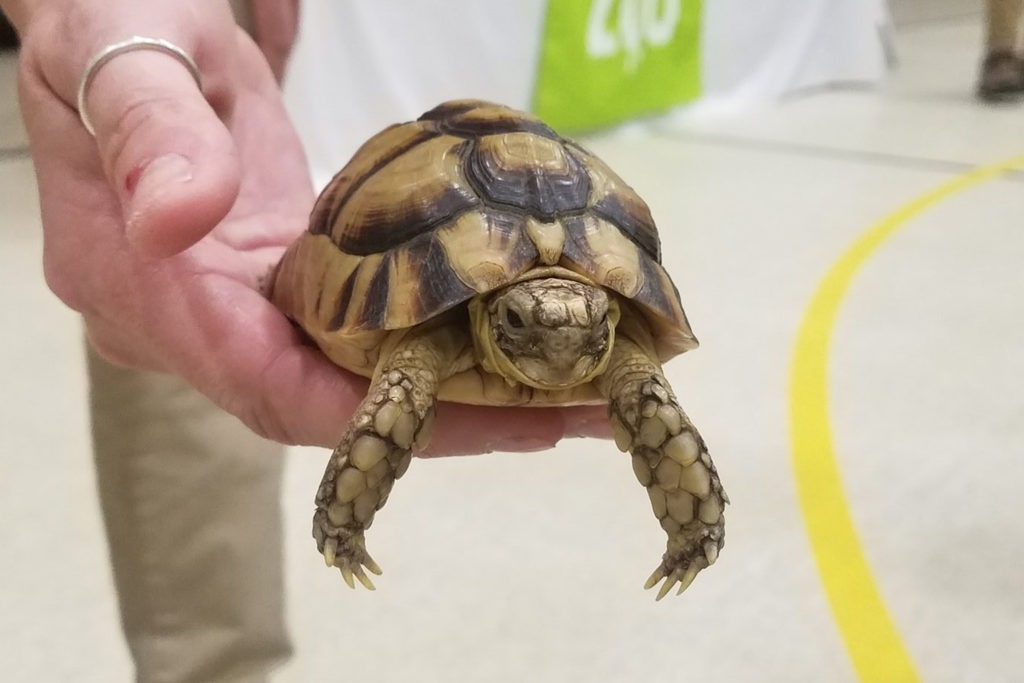Overview
“Where I live”
Egyptian tortoises are native to the desert that fringes the southern shore of the Mediterranean Sea. They were once found in Libya, Egypt, and Israel but are now isolated to small patches of territory only in Libya. They are considered extinct elsewhere.
The Zoo has one Egyptian tortoise in its Animal Embassy collection. Animal Ambassadors from this collection are introduced to audiences in education programs on and off grounds.
“How I live there”
Egyptian tortoises are desert animals that survive extreme aridity through a combination of physical and behavioral adaptation. Their small size allows them to quickly adjust their body temperature and avoid overheating. Their pale coloring – about the same color as sand – lets them reflect heat while also blending into the landscape to avoid predation. They are active during the day but choose to forage when it is coolest and rest during the high heat. This means that they are most active browsing for food at dawn and at dusk. When resting, they seek shelter under bushes or in rodent burrows.
All animals need water to survive. Desert animals can survive on very little water but they still have to get it somehow. Since there is no surface water where Egyptian tortoises live, they get their water by sucking moisture from desert plants. They do this by plucking at plant stems with their beak-like jaws. They retain as much water as possible by excreting concentrated uric acid as waste rather than more dilute urine.
“Making my mark”
Egyptian tortoises are recognizable for their size and their high-domed carapaces.
“What eats me”
Desert monitor lizards and some birds of prey, including ravens, prey on Egyptian tortoises and eggs, but humans are their most significant predator.
Raising Young
Although courtship and mating in the wild have rarely been observed, both are believed to occur in spring. Males bump and sometimes chase their prospective mates and make a distinctive mating call that sounds like the call of a mourning dove. Females lay clutches of 1 to 5 eggs in shallow depressions beneath bushes or in abandoned rodent burrows. The eggs hatch in early summer. The baby turtles remain inactive and hidden through the summer but begin to come out and forage as the weather cools in the fall.
Conservation
Egyptian tortoises are listed as critically endangered by the IUCN, the world’s leading conservation organization. They are threatened by habitat loss, over-collection for the pet trade, and resource competition. Much of the tortoises’ former range has been developed into cities, resorts, and farmland, pushing tortoises and other desert animals out.
In patches of desert where the tortoises remain, they do so under mounting pressure. Food has become increasingly scarce because camels and goats are grazing on the same plants that the tortoises eat and Bedouin herders collect many of the same plants for fuel, building materials, and herbal remedies. Meanwhile, the tortoises are trying to adapt to more subtle changes inflicted on their fragile environment by humans. Vehicles running through the desert crush delicate vegetation, for example, while newly-erected telephone poles provide potential nesting sites for birds that prey on the tortoises.
Even though it is illegal in Egypt and internationally to capture or trade Egyptian tortoises, the species is not protected in Libya. Egyptian tortoises have been collected nearly to extinction and because of their low reproductive rate, do not bounce back easily in the wild.
Taxonomy
- Kingdom: Animalia
- Phylum: Chordata
- Subphylum: Vertebrata
- Class: Reptila
- Genera: Testudo
- Species: kleinmanni
What is an Animal Ambassador?
The Maryland Zoo refers to its special collection of education program animals as “Animal Ambassadors.” The Zoo currently cares for more than 60 Animal Ambassadors, representing more than 40 species, both native and exotic. These animals are managed separately from the rest of the Zoo’s collection and cannot be seen on exhibit at the Zoo. However, many can be seen up close and personal on a rotating basis at Creature Encounters, the Zoo’s outdoor education center; at camp and school programs at the Zoo; as featured participants in community-based Outreach programs; and at special events on and off Zoo grounds.
Animal Ambassadors spend countless hours working with their human handlers, developing bonds of trust and communication that will allow them to appear in front of audiences large and small. They are not show animals. They behave naturally, focusing audiences’ attention on their natural behaviors and adaptations and giving living, breathing meaning to concepts and topics that students may be studying.
Animal Ambassadors travel all over the state of Maryland and beyond, and many also make local and national media appearances, educating about wildlife while representing the Zoo and its commitments to animal welfare and conservation.
What is The Animal Embassy?
The Animal Embassy at The Maryland Zoo is an off-exhibit area that is not open to the public. It is where the Zoo’s “Animal Ambassadors,” or education program animals, live. The Embassy is home to more than 60 individual animals representing more than 40 different species. It is staffed by its own dedicated group of keepers and volunteers and has both indoor and outdoor living space for the animals.


